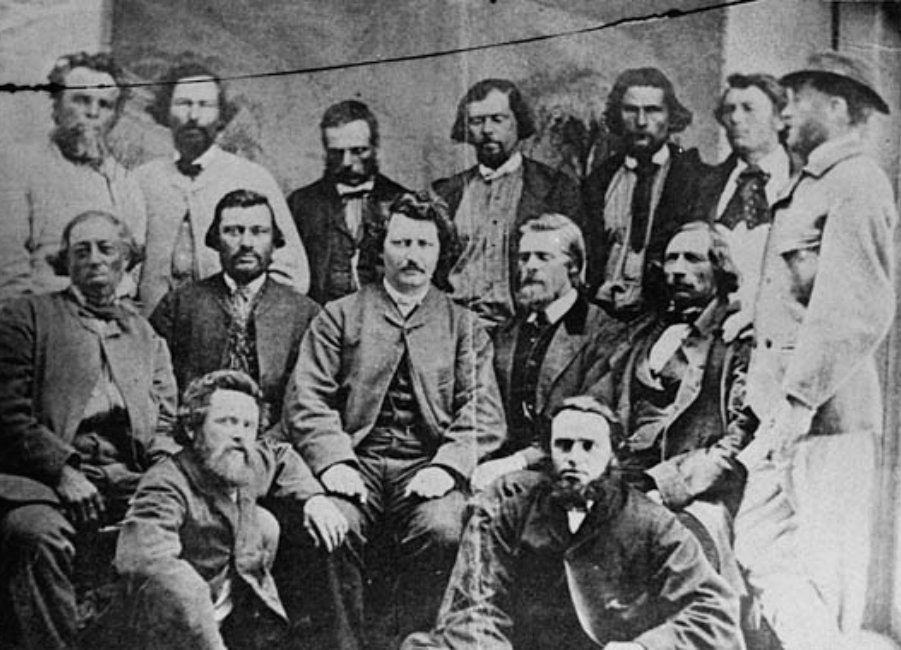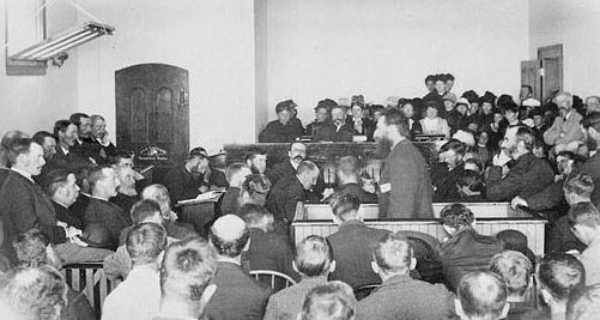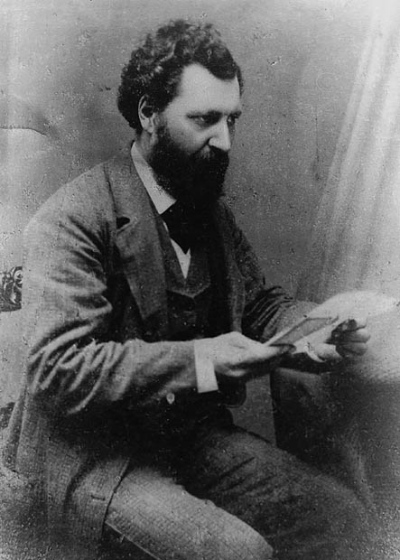
Louis Riel
Louis Riel was born on October 22, 1844, in the Red River Settlement, a predominantly Métis community situated within what today is called the province of Manitoba. A gifted student, Riel was selected at 13 for priesthood and sent to Montreal for his schooling, but young Louis left priesthood candidacy in 1865 after the death of his father. To make matters worse, Riel’s engagement with his fiancée, Marie-Julie-Guernon, was called off after her parents found out about his Métis roots. In 1868, Riel returned to his mother’s cottage at the Red River Settlement.
After arriving at his mother’s, he observed the growing unrest between Métis and Anglophone settlers. These tensions were partially incited by the Hudson’s Bay Company (HBC) negotiations that aimed to sell Rupert’s Land, a vast amount of territory which included the Red River Settlement, to the Dominion of Canada. The negotiations did not include any representatives of the Métis people, who resented that the fate of their home was being decided without their input. Surveyors were sent to the area before the sale was even finalized, increasing agitation as the surveys implemented a grid-system which cut across existing Métis lots.
Riel & The Red River Resistance/Rebellion
In response, the Métis community of Red River founded the Métis National Committee, Riel was elected secretary, and then later he presided as president of the group. The Red River Resistance/Rebellion had begun. The committee disrupted the work of the surveyors, and on November 2nd, 1869, blockaded the newly appointed, non-bilingual lieutenant-governor, William McDougall, from entering the region via the American border. On that same day, a group of Métis led by Riel seized Fort Garry (in current-day Winnipeg) from the HBC. Not only was this the first physical act of resistance to the transfer of Rupert’s Land, it established Riel as a Métis leader and activist. In early December 1869, the Committee evolved into a provisional government, which rejected Canada’s authority over Rupert’s Land.
The provisional government under Riel drafted a “List of Rights” to ensure the continued protection of the rights of the Métis living in the region. They sent delegates to Ottawa to negotiate the terms of Rupert’s Land entry into Canada in March of 1870 and a consensus was reached with the passing of the Manitoba Act based on the Métis List of Rights. The bill established the bilingual province of Manitoba and included provisions for protection of Métis land and language rights.
Meanwhile, however, the provisional government met counter-resistance from the “Canadian Party,” a group of Anglophones authorized by McDougall to use armed force against Riel’s organization. On the 17th of February 1869, a group of 48 men from the Canadian Party were intercepted and arrested by Riel’s men near Fort Garry. Riel sentenced one of these men, a Protestant surveyor named Thomas Scott, to death. After Scott’s execution by a Métis firing squad on the 4th of March, a Canadian military expedition was dispatched to the Red River. Although the expedition was intended to oversee peace negotiations, some Protestant militia members wanted revenge for Scott’s death, and fearing arrest or assassination, Riel fled to the U.S in 1873.
Riel & The North-West Resistance/Rebellion
During his exile in early 1885, Riel was visited by a group of Métis men from northern Saskatchewan where many Métis had settled after the events of 1869. The Métis communities there had for a while resumed their traditional lifeways, however, a new influx of settlers disrupted the land agreement between the Batoche Métis and the Canadian government. The men had arrived to ask Riel to return to Canada and help lead them against the government. Riel enthusiastically accepted. He assisted them in creating a “Revolutionary Bill of Rights,” and upon seizing a parish church in Batoche Louis Riel again headed a provisional government. On the 21st of March 1885, Riel ordered the capture of Fort Carlton, beginning the battles of the North-West Resistance (also commonly known as the North-West Rebellion). After two months of fighting, Métis forces were overpowered by the Canadian militia at Batoche on the 12th of May. Riel was subsequently charged with treason, sentenced to death, and hanged on the 16th of November 1885.
Riel’s legacy is complex and controversial. He is celebrated by many as a hero and champion of Métis rights and culture, and his actions are seen as an important milestone in the history of Canadian democracy and political justice. However, his role in the North-West Resistance/Rebellion and the controversial execution of Thomas Scott have been heavily criticized. In 1992, the Canadian government formally recognized Riel as a founder of Manitoba and a key figure in the history of the Métis people. Riel is the subject of numerous books, films, and works of art, and his image has been used to represent a wide range of political and social causes. His story serves as a powerful reminder of the complicated and often tense relationship between Indigenous peoples and the Canadian government.

Louis Riel Addressing the Jury at his Trial for Treason, July 1885. (Credit: Library and Archives Canada, M#3192595)
Additional Links:
For additional information about the life and legacy of Louis Riel, see the Government of Manitoba’s site, or view illustrated excerpts from Riel’s life in Chester Brown’s Louis Riel: A Comic-Strip Biography.
- Louis Riel Day Information site from Manitoba Government: https://www.gov.mb.ca/chc/louis_riel/index.html
- Chester Brown’s Louis Riel: A Comic-Strip Biography: https://www.famous-trials.com/louisriel/845-comics
Images:
Main photo: Louis Riel (centre) and Councillors of the Provisional Government of the Métis Nation, June 1870. (Credit: Library and Archives Canada, M#3194516).
Sources:
Braz, Albert. The False Traitor: Louis Riel in Canadian Culture. Toronto: University of Toronto Press, 2003.
Brown, Chester. Louis Riel: A Comic-Strip Biography. Montreal: Drawn and Quarterly, 2010.
Doyle, David. Louis Riel: Let Justice Be Done. Vancouver: Ronsdale Press, 2017.
Ens, Gerhard. Homeland to Hinterland: The Changing Worlds of the Red River Metis in the Nineteenth Century. Toronto: University of Toronto Press, 1996.
Stewart, Sharon. Louis Riel: Firebrand. Dundurn: Dundurn Press, 2007.


